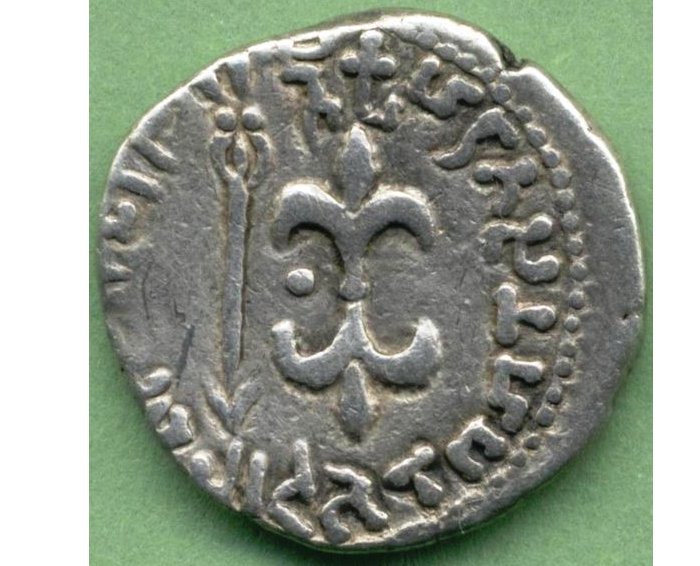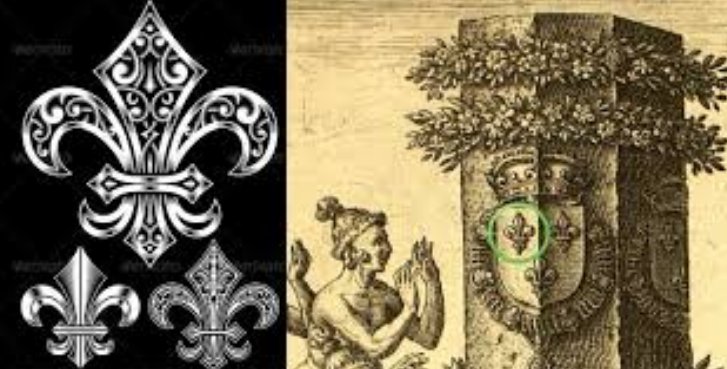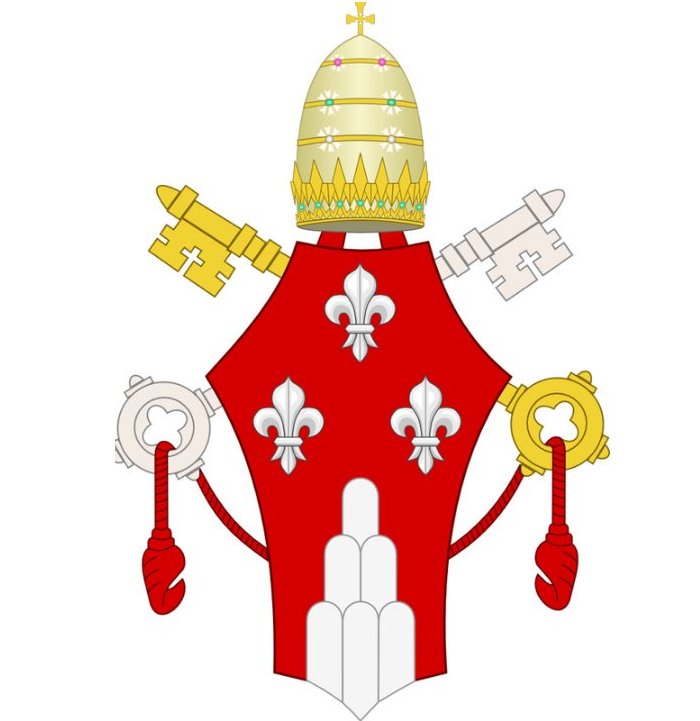Ancient Symbol Fleur-de-lis: It’s Meaning And History Explained
Ellen Lloyd - AncientPages.com - Fleur-de-lis, ( French: “lily flower”) is an ancient symbol that has long been associated with French royalty. Depicting a stylized lily or lotus flower we encounter the emblem in many places across the world.
What makes the Fleur-de-lis symbol special is how it has been used in different contexts. This symbol has represented peace, war, religion, politics, royalty, and more.
For example, Joan of Arc carried a white banner that showed God blessing the French royal emblem, the fleur-de-lis when she led French troops to victory over the English. The Catholic Church has used the Fleur-de-lis emblem for many years. The lily flower was a symbol of the Holy Trinity as well as an emblem of the Virgin Mary.
A number of military units use the symbol's resemblance to a spearhead to identify martial power and strength.
Why Is The Fleur-de-lis – Lily Flower A Symbol Of Royalty?
Fleur-de-lis (also 'fleur-de-lys') should not be confused with the Flower of Life, which is an ancient sacred geometry symbol and blueprint of the universe.
The fleur-de-lis symbol was sporadically used in Babylonian, Indian, Egyptian, and Roman architecture, but it is most associated with French royalty and the Church.
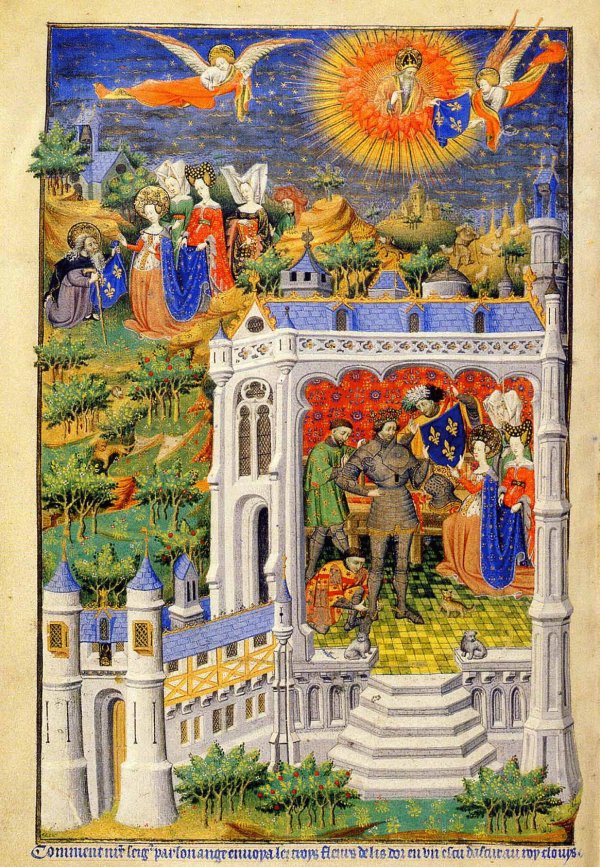
15th-century manuscript illumination of an angel sending the fleurs-de-lis to Clovis. From the Bedford Hours in the British Library, London. via Wikipedia
The fleur-de-lis' symbolic association with French monarchs may stem from the baptismal lily used in the crowning of King Clovis I.
An ancient legend tells, a golden lily flower given at his baptism to Clovis, king of the Franks (466–511), by an angel or even the Virgin Mary. The lily was said to have sprung from the tears shed by Eve as she left Eden. The lily flower was a symbol of his purification upon his conversion to Christianity.
According to another legend, Clovis adopted the symbol when waterlilies showed him how to safely cross a river and thus succeed in battle.
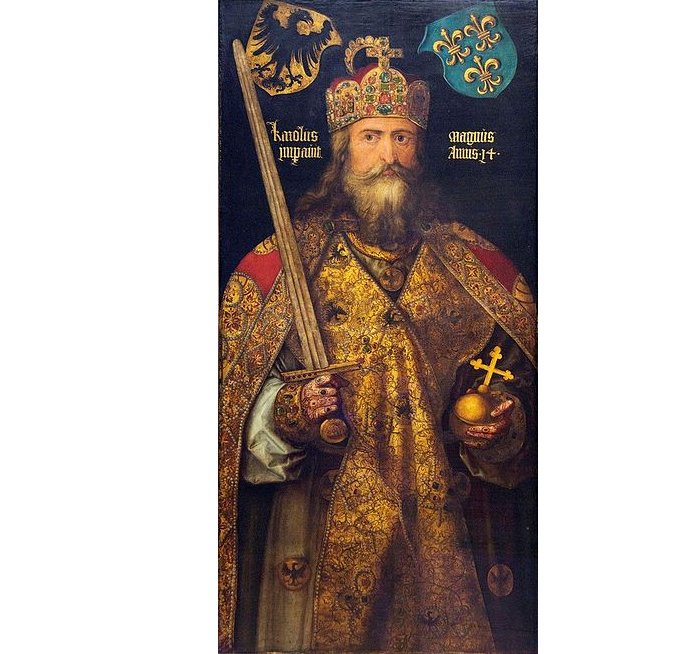
Charlemagne, by Albrecht Dürer, the anachronistic coat-of-arms above him shows the German eagle and the French Fleur-de-lis. Image credit: Albrecht Dürer - The Yorck Project (2002)/via wikipedia
The symbol has been regarded as a sign of purity ever since antiquity. The Roman Catholic Church adopted the Fleur-de-lis symbol to represent the Virgin Mary. When Pope Leo III in 800 crowned Charlemagne as emperor, he is reported to have presented him with a blue banner covered (semé) with golden fleurs-de-lis.
The symbol was later adopted by many European noble families, most notably the French monarchy, to establish an association with the Church.
In the twelfth century, either King Louis VI or King Louis VII became the first French monarch to use the fleur-de-lis on his shield.
In the 14th century, the fleur-de-lis was often incorporated into the family insignia that was sewn on the knight's surcoat, which was worn over their coat of mail, thus the term, "coat of arms." The original purpose of identification in battle developed into a system of social status designations after 1483 when King Edmund IV established the Heralds' College to supervise the granting of armor insignia.
See also:
12 Ancient Egyptian Symbols Explained
Ouroboros: Ancient Infinity Symbol Used By Different Ancient Civilizations
Well-Known Powerful Yin Yang Symbol Dates Back To Ancient China
How The Fleur-de-lis Symbol Became Popular On Other Continents
Knowledge of Fleur-de-lis crossed the Atlantic when French settlers reached the New World. Their presence on North American flags and coats of arms usually recalls the involvement of French settlers in the history of the town or region concerned, and in some cases, the persisting presence there of a population descended from such settlers.
The fleur-de-lis symbol also appears on the Canadian coat of arms, the flag of Quebec.
The Fleur-de-lis Symbol In Modern TImes
In modern times, we encounter the fleur-de-lis symbol in a variety of areas. It is a symbol associated with military, sport, education, scouting, and literature.
Written by Ellen Lloyd – AncientPages.com
Copyright © AncientPages.com All rights reserved. This material may not be published, broadcast, rewritten or redistributed in whole or part without the express written permission of AncientPages.com
Expand for referencesMore From Ancient Pages
-
 Scientists Found Mysterious Prophecies In Ancient Egyptian Pyramid – Are They Linked To The Strange Visions Some Experience Inside?
Featured Stories | Dec 17, 2024
Scientists Found Mysterious Prophecies In Ancient Egyptian Pyramid – Are They Linked To The Strange Visions Some Experience Inside?
Featured Stories | Dec 17, 2024 -
 2,600-Year-Old Blocks Of White Cheese Discovered At Giza’s Saqqara Necropolis, Egypt
Archaeology | Sep 15, 2022
2,600-Year-Old Blocks Of White Cheese Discovered At Giza’s Saqqara Necropolis, Egypt
Archaeology | Sep 15, 2022 -
 Siberian Neanderthals Were Intrepid Nomads – They Started Their Journey In Eastern Europe
Archaeology | Jan 29, 2020
Siberian Neanderthals Were Intrepid Nomads – They Started Their Journey In Eastern Europe
Archaeology | Jan 29, 2020 -
 Virginia’s Mysterious Vault With Remarkable Secret Ancient Documents Still Raises Many Questions
Featured Stories | Oct 17, 2024
Virginia’s Mysterious Vault With Remarkable Secret Ancient Documents Still Raises Many Questions
Featured Stories | Oct 17, 2024 -
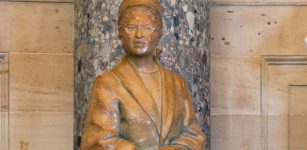 On This Day In History: Rosa Parks’ Act Of Defiance And The Montgomery Bus Boycott – On Dec 1, 1955
News | Dec 1, 2016
On This Day In History: Rosa Parks’ Act Of Defiance And The Montgomery Bus Boycott – On Dec 1, 1955
News | Dec 1, 2016 -
 What A Bath, Taken 1,000 Years Ago, Can Tell Us About The Conflicted English Kingdom Of The 11th Century
Featured Stories | Jun 14, 2024
What A Bath, Taken 1,000 Years Ago, Can Tell Us About The Conflicted English Kingdom Of The 11th Century
Featured Stories | Jun 14, 2024 -
 Unknown Holographic Technology Hidden In Old Monastery Reveals A Surprising Secret
Ancient Mysteries | Dec 7, 2018
Unknown Holographic Technology Hidden In Old Monastery Reveals A Surprising Secret
Ancient Mysteries | Dec 7, 2018 -
 ‘Viking Disease’ Hand Disorder May Come From Neanderthal Genes
Archaeology | Jun 14, 2023
‘Viking Disease’ Hand Disorder May Come From Neanderthal Genes
Archaeology | Jun 14, 2023 -
 Evidence Humans Used Fire 1 Million Years Ago In Israel Discovered By Artificial Intelligence
Archaeology | Jun 15, 2022
Evidence Humans Used Fire 1 Million Years Ago In Israel Discovered By Artificial Intelligence
Archaeology | Jun 15, 2022 -
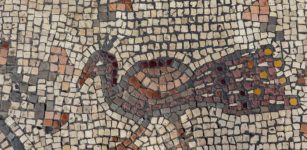 Biblical Mosaic Depicting Miracles Of Jesus Discovered At The ‘Burnt Church’ In Hippos
Archaeology | Sep 24, 2019
Biblical Mosaic Depicting Miracles Of Jesus Discovered At The ‘Burnt Church’ In Hippos
Archaeology | Sep 24, 2019 -
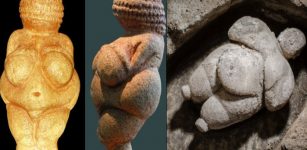 ‘Venus of Willendorf’: New Theory On ‘Venus’ Figurines – Proposed
Artifacts | Dec 1, 2020
‘Venus of Willendorf’: New Theory On ‘Venus’ Figurines – Proposed
Artifacts | Dec 1, 2020 -
 On This Day In History: First Public And Free School Opened For Poor Children – On Sep 15, 1616
News | Sep 15, 2016
On This Day In History: First Public And Free School Opened For Poor Children – On Sep 15, 1616
News | Sep 15, 2016 -
 8200-Year-Old ‘Viste Individual’ – DNA Analysis May Shed Light On Early Migration To Norway
Archaeology | Dec 6, 2015
8200-Year-Old ‘Viste Individual’ – DNA Analysis May Shed Light On Early Migration To Norway
Archaeology | Dec 6, 2015 -
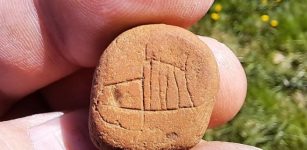 Small Stone Carved With A Viking Ship May Be Oldest Picture Ever Found In Iceland
Archaeology | Jun 16, 2023
Small Stone Carved With A Viking Ship May Be Oldest Picture Ever Found In Iceland
Archaeology | Jun 16, 2023 -
 Neanderthals Weaned And Raised Their Children Similarly To Modern Humans
Archaeology | Nov 3, 2020
Neanderthals Weaned And Raised Their Children Similarly To Modern Humans
Archaeology | Nov 3, 2020 -
 Cats In The Middle Ages: What Medieval Manuscripts Teach Us About Our Ancestors’ Pets
Featured Stories | Dec 24, 2022
Cats In The Middle Ages: What Medieval Manuscripts Teach Us About Our Ancestors’ Pets
Featured Stories | Dec 24, 2022 -
 Ashur – First Capital And Powerful Religious Center Of The Assyrian Empire
Featured Stories | Jun 28, 2019
Ashur – First Capital And Powerful Religious Center Of The Assyrian Empire
Featured Stories | Jun 28, 2019 -
 Abydos: One Of The Most Important Cities Of Ancient Egypt
Featured Stories | Jul 15, 2016
Abydos: One Of The Most Important Cities Of Ancient Egypt
Featured Stories | Jul 15, 2016 -
 Evidence Of Biblical Kingdom Of Edom In Arava Desert – Discovered
Archaeology | Sep 23, 2019
Evidence Of Biblical Kingdom Of Edom In Arava Desert – Discovered
Archaeology | Sep 23, 2019 -
 Unexpected Discovery 130,000-Year-Old Neanderthal Stone Tools In Poland
Archaeology | Oct 30, 2023
Unexpected Discovery 130,000-Year-Old Neanderthal Stone Tools In Poland
Archaeology | Oct 30, 2023

